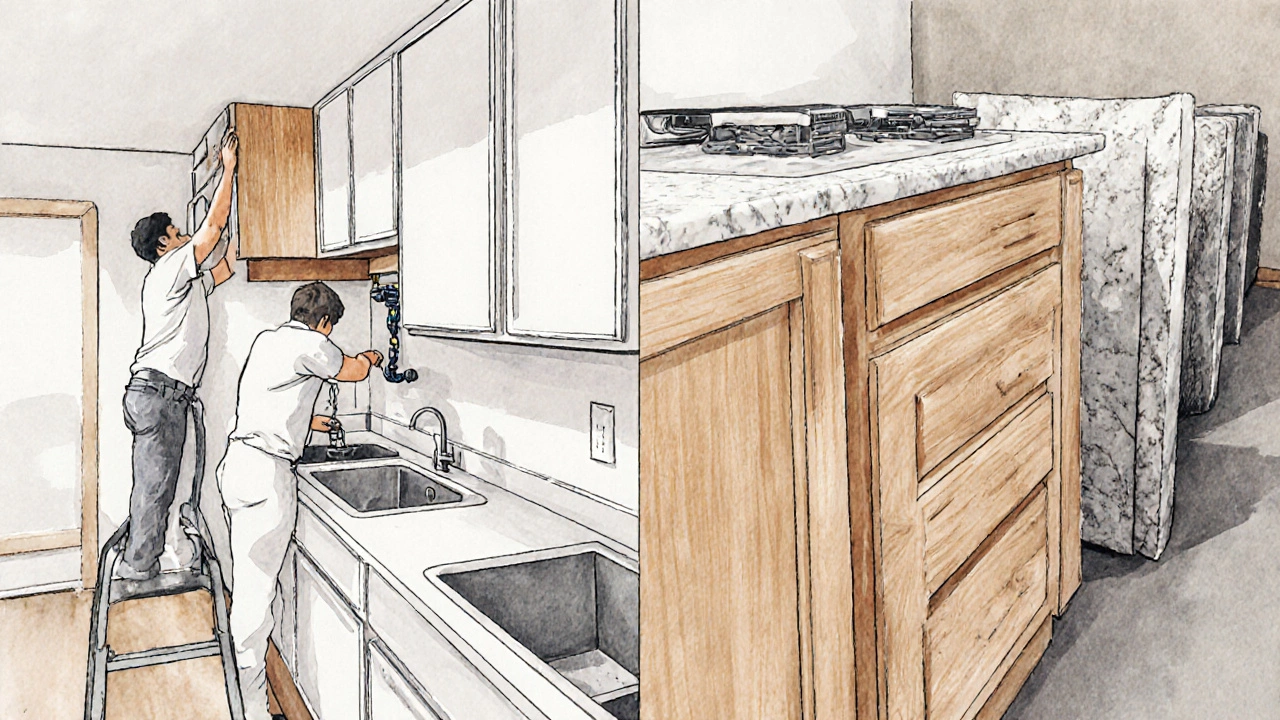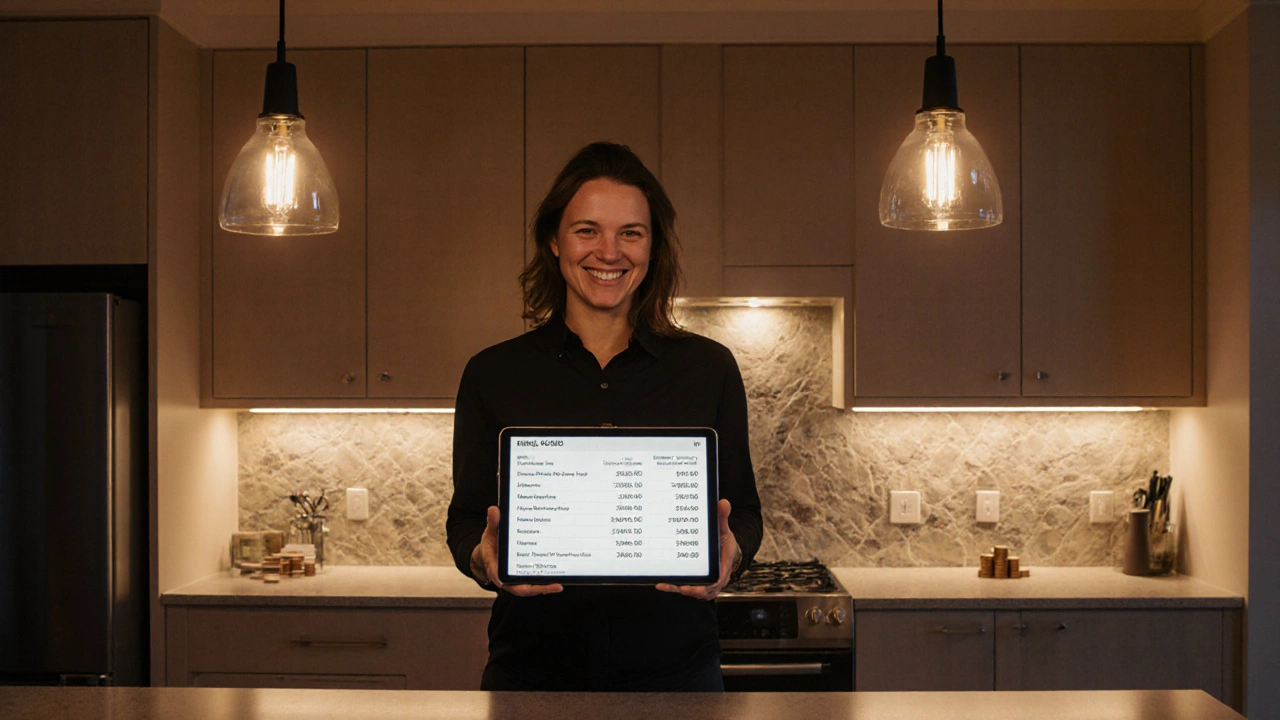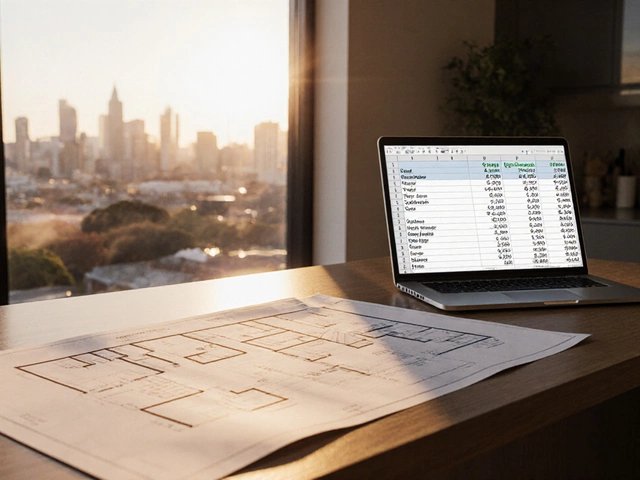Kitchen Fitting Cost Estimator
Calculate Your Kitchen Fitting Cost
Enter your kitchen details to get a realistic estimate based on Auckland 2025 market rates.
Cabinet & Countertop Selection
Appliance Selection
Labour Option
Estimated Kitchen Fitting Cost
Thinking about a brand‑new kitchen but wondering how much you’ll actually pay to get it installed? You’re not alone. Homeowners across Auckland are trying to balance dream designs with real‑world budgets, and the price tag can feel like a mystery. This guide breaks down every factor that shapes a kitchen fitting cost, shows you realistic price ranges for 2025, and gives you a step‑by‑step plan to get accurate quotes without the guesswork.
Key Takeaways
- Typical kitchen fitting totals in Auckland range from NZ$12,000 to NZ$35,000 for a standard 10‑square‑metre layout.
- Labour rates, cabinet quality, appliance choice, and plumbing complexity drive the biggest price swings.
- Request detailed, itemised quotes from at least three local installers to avoid hidden fees.
- DIY installation can shave 20‑30 % off labour costs, but only if you have the right tools and experience.
- Plan a 10‑15 % contingency to cover unexpected work or design changes.
Below you’ll find everything you need to understand, budget, and negotiate a kitchen fitting project that fits your lifestyle and wallet.
What Exactly Is "Kitchen Fitting"?
Kitchen fitting is the process of installing cabinets, countertops, appliances, plumbing, and electrical work to turn a bare space into a functional kitchen. It covers everything from removing old fixtures to hanging new cabinets, connecting appliances, and finishing the floor and backsplash. In New Zealand, the term often includes project management, permits (if needed), and final compliance checks.
Why Prices Differ So Much
Two kitchens can look almost identical on a showroom floor, yet their final bills can be worlds apart. The main cost drivers are:
- Labour rates. Skilled carpenters, electricians, and plumbers command different hourly fees based on experience and location.
- Cabinetry quality. Custom‑built, solid‑wood cabinets cost far more than prefabricated MDF units.
- Appliance choices. High‑end ovens, built‑in refrigerators, and smart hobs add a premium.
- Plumbing and electrical complexity. Moving gas lines or adding a new circuit can quickly inflate the budget.
- Finishing details. Backsplashes, premium flooring, and lighting fixtures each carry separate price tags.
Average Price Ranges in Auckland (2025)
Below is a snapshot of what homeowners typically spend for a standard 10‑square‑metre kitchen fit‑out in Auckland, broken down by service tier.
| Tier | Total Cost (NZ$) | Labour (NZ$) | Cabinets & Countertops | Appliances | Finishes & Misc. |
|---|---|---|---|---|---|
| Budget | 12,000 - 18,000 | 4,000 - 6,000 | 3,500 - 5,000 (prefab MDF) | 2,000 - 3,500 (standard brands) | 1,500 - 3,500 (basic tiles, LED lighting) |
| Mid‑range | 18,000 - 25,000 | 6,000 - 8,000 | 5,500 - 8,000 (semi‑custom or solid timber) | 3,500 - 5,500 (mid‑tier appliances) | 2,500 - 4,500 (designer backsplash, under‑cab lighting) |
| High‑end | 25,000 - 35,000+ | 8,000 - 12,000 | 8,000 - 12,000+ (custom high‑grade timber or stone) | 5,500 - 9,000+ (premium brands, built‑in fridge) | 4,500 - 7,000+ (natural stone, high‑spec lighting) |

Breaking Down the Costs
Let’s unpack each column so you know exactly where your money goes.
Labour
Labour rates in Auckland typically range from NZ$80 to NZ$130 per hour for qualified carpenters, with electricians and plumbers charging a similar premium. A full kitchen fit‑out can require 120‑200 man‑hours, depending on complexity.
Cabinetry & Countertops
Choosing between prefabricated MDF, semi‑custom softwood, or fully custom solid timber dramatically shifts cost. Countertop material also matters-a laminate surface starts around NZ$80/m², whereas a quartz slab can top NZ$250/m².
Appliances
Standard 2025 kitchen packages (oven, hob, dishwasher) average NZ$3,000‑5,000. High‑end smart appliances can push that figure past NZ$8,000. Don’t forget installation fees for gas or special ventilation.
Finishes & Miscellaneous
This includes backsplashes, floor coverings, lighting, and any extra plumbing fixtures. A modest tile backsplash might be NZ$30/m², while natural stone runs NZ$150/m². Lighting can range from basic LED strips (NZ$50 each) to designer pendant lights (NZ$300+ each).
How to Get an Accurate Quote
The biggest mistake homeowners make is relying on a single, vague estimate. Follow this four‑step process to secure a clear, comparable quote.
- Define your scope. Prepare a simple brief that lists:
- Exact kitchen dimensions (measure length, width, ceiling height).
- Desired cabinet style and material.
- Appliance list (model numbers if you have preferences).
- Any structural changes (e.g., moving a wall or adding a window).
- Gather three local installers. Search for Auckland kitchen installer firms, check their reviews on Trade Me or local directories, and request written quotes.
- Ask for an itemised breakdown. A good quote separates labour, materials, disposal, and contingency. Look for hidden line items like "site cleanup" or "permit fees".
- Compare and negotiate. Use the lowest‑priced item as leverage. Most installers are willing to adjust finishes or suggest cost‑saving alternatives (e.g., swapping quartz for engineered stone).
DIY vs. Professional Installation
Rolling up your sleeves can save money, but it also carries risks. Here’s a quick comparison.
| Aspect | DIY | Professional |
|---|---|---|
| Initial Cost | ~30 % less (labour saved) | Full labour rates |
| Time Required | 1‑2 weeks extra (learning curve) | 5‑7 days typical |
| Quality Assurance | Varies - depends on skill | Warranty on workmanship |
| Permits & Compliance | May need to self‑manage | Handled by installer |
| Risk of Damage | Higher (potential to ruin cabinets) | Low (experienced crew) |
If you’re handy, confident with power tools, and have time, DIY can be rewarding. Otherwise, the peace of mind from a licensed kitchen installer who follows New Zealand building codes and health & safety standards is worth the extra spend.

Tips to Keep Your Kitchen Fit‑Out on Budget
- Reuse existing appliances. If your fridge or dishwasher still works, keep it to shave thousands off.
- Standardize cabinet dimensions. Off‑the‑shelf sizes avoid custom cuts, which add labour.
- Choose neutral finishes. White or grey cabinets pair well with most appliances and are cheaper than exotic veneers.
- Plan the layout early. Moving a sink or stove after cabinets are installed can cost an extra NZ$2,000‑3,000.
- Book contractors during off‑season. Auckland’s construction lull in late autumn often yields better rates.
- Set a contingency fund. 10‑15 % of the total budget protects you from surprise plumbing or electrical work.
Typical Timeline for a Kitchen Fit‑Out
From demolition to the final walkthrough, most Auckland projects follow this schedule.
- Week 1: Design finalisation & permit applications (if needed).
- Week 2‑3: Demolition, disposal, and site preparation.
- Week 4‑5: Rough‑in plumbing and electrical work.
- Week 6‑7: Cabinet and countertop installation.
- Week 8: Appliance delivery, hookup, and final finishes.
- Week 9: Inspection, snagging list, and handover.
Delays can happen if trades are booked late or if unexpected issues (like hidden water damage) arise. Keeping a clear communication channel with your installer helps keep things on track.
Frequently Asked Questions
How much does a basic kitchen fitting cost in Auckland?
A basic fit‑out for a 10 m² kitchen typically runs between NZ$12,000 and NZ$18,000, including labour, standard cabinets, basic appliances, and simple finishes.
Are permits required for a kitchen remodel?
If you’re only swapping cabinets and appliances, a permit isn’t usually needed. However, moving plumbing, gas lines, or structural walls does require a building consent from the Auckland Council.
What’s the biggest hidden cost people forget?
Disposal of old cabinets and appliances can add NZ$500‑1,000 to the bill, especially if hazardous materials like old refrigerants are involved.
Can I install the kitchen myself and still claim a warranty?
Most manufacturers only honor warranties if the installation follows their certified installer network. DIY work may void the warranty on cabinets or appliances.
How long should a professional kitchen fitting take?
For an average-sized kitchen, expect 5‑9 working days once demolition is completed. Complex layouts or high‑end finishes can stretch the timeline to two weeks.
Next Steps: From Planning to Moving In
Now that you know the numbers, it’s time to act.
- Sketch your ideal layout on graph paper or using a free app like Planner 5D. Include measurements and note any walls you might move.
- Research three local Auckland based kitchen fitting companies. Check their portfolio and read recent customer reviews.
- Send each company a brief email with your scope and ask for an itemised quote.
- When quotes arrive, plug the figures into the comparison table above. Highlight any line items that seem unusually high.
- Schedule a site visit with your top two choices. Use this meeting to ask about their warranty, insurance, and how they handle unexpected issues.
- Choose the installer that offers the best balance of price, timeline, and confidence level. Sign a contract that spells out payment milestones, completion date, and a clear handover procedure.
- Prepare your home for demolition (clear countertops, protect flooring) and set aside a small storage area for appliances you plan to keep.
Follow these steps, keep a 10‑15 % contingency, and you’ll walk into a brand‑new kitchen without any nasty financial surprises.
Remember, a well‑executed kitchen fit‑out not only makes daily cooking smoother but also adds solid resale value to your Auckland home. Happy renovating!

Write a comment